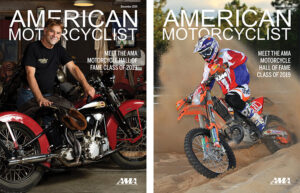AMERICAN MOTORCYCLIST December 2019
AMA Motorcycle Hall of Fame Class of 2019
A champion of motorcyclists’ rights. A trials pioneer. A motocross legend. A tireless ambassador of motorcycling heritage. And a beloved off-road racer who transcended his sport.These are the members of the AMA Motorcycle Hall of Fame Class of 2019. They will join other greats of motorcycling at the induction ceremony on Dec. 6 in Columbus Ohio. They represent the highest levels of achievement in competition, advocacy and fulfilling the AMA mission to promote the motorcycle lifestyle and protect the future of motorcycling. Here are their stories.
Ron Lechien
 Ron Lechien will always be regarded as one of the fastest, most stylish and naturally talented motocross/supercross racers of all time. Lechien quickly rose to stardom in the 1980s, arguably the most competitive era of the sport, and was almost immediately successful in every discipline he entered, both on the AMA circuit and the international stage.
Ron Lechien will always be regarded as one of the fastest, most stylish and naturally talented motocross/supercross racers of all time. Lechien quickly rose to stardom in the 1980s, arguably the most competitive era of the sport, and was almost immediately successful in every discipline he entered, both on the AMA circuit and the international stage.
All told, Lechien would win 26 AMA Supercross/Pro Motocross races, as well as the 1985 AMA 125cc National Motocross Championship. He also helped guide the U.S. team to a pair of wins at the annual FIM Motocross des Nations.
As efficient and disciplined as Lechien (nicknamed “Dogger”) was on the racetrack, away from it he was quite different. The challenges and temptations that came with success at such a young age would ultimately cost him in the long run, and his mercurial professional racing career ended nearly as quickly as it began.
Lechien was born in El Cajon, Calif., a suburb of San Diego, in a neighborhood that has produced an astonishing amount of motocross talent. Lechien is the fifth AMA Motorcycle Hall of Famer to come from El Cajon, joining Marty Smith (Class of 2000), Marty Tripes (2001) and his former rivals and teammates Rick Johnson (1999) and Broc Glover (2001) with this distinction.
After Ron showed early promise on minicycles, his father, Dick Lechien, founder of Maxima Lubricants, started taking his son to major youth and amateur events. It was at the 1981 Mammoth Mountain Classic that the youngster served notice to the motocross world that he was going to be a force in racing by winning the highly-competitive 125 Pro class at just 14 years of age.
One year later, Lechien became the first superstar graduate of the new AMA Amateur National Motocross Championship at Loretta Lynn’s Ranch in Hurricane Mills, Tenn., winning the 125 Expert and 125 Schoolboy titles. He was rewarded with a Yamaha factory contract to turn pro in 1983, as soon as he turned 16.
Success came quickly. Three months after entering his first AMA Supercross, he won the Orlando Supercross, in the premier 250 class. Eight days later, Lechien won the AMA 125 National at Lake Whitney, Texas.
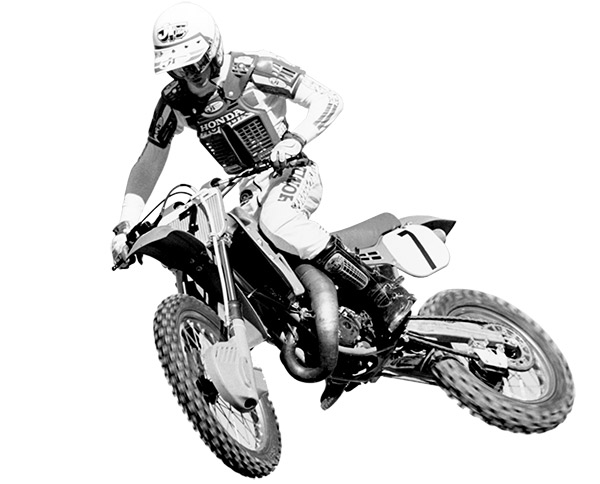
Before his next season as a pro started, Lechien made a big change, leaving Yamaha to ride for the juggernaut that was Team Honda in 1984. The team included three AMA Motorcycle Hall of Famers—Bob Hannah (1999), David Bailey (1999) and Johnny O’Mara (2000). Lechien moved up to the 250 class, despite his relatively young age, and, while he won a few races, his lack of experience showed. But there were also flashes of brilliance. In his first U.S. Grand Prix of Motocross, at Unadilla in New York, Lechien became the youngest-ever 250cc Grand Prix winner.
In 1985, Team Honda returned Lechien to the 125 class in Pro Motocross, and he responded by absolutely dominating that summer’s AMA 125 National Motocross Championship. When the season ended, he joined his teammate Bailey and Jeff Ward of Team Kawasaki in representing the United States in winning the Motocross des Nations in Gaildorf, West Germany.
Unfortunately Lechien’s time with Honda was short-lived, as a brush with the law on a visit to Japan resulted in the termination of his contract. He was quickly picked up by Kawasaki, where he would spend the next four seasons, winning multiple AMA Supercross races and outdoor nationals. But Lechien never notched another championship title, as his inconsistency proved costly.
Lechien raced his last AMA Supercross in 1994 in his San Diego hometown as a veteran privateer and finished 13th.
“I am extremely honored to be going into the AMA Motorcycle Hall of Fame,” Lechien said. “I’ve waited and been hoping for a long time that I would get in, and now that it’s finally happening, it’s just unreal.” —Davey Coombs
Kurt Caselli
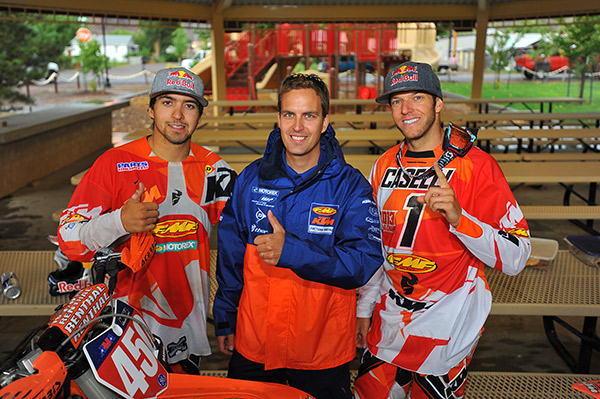 Few off-road racers have been as respected and well-regarded as the late Kurt Caselli—and perhaps no other has achieved such admiration in a career cut so tragically short.
Few off-road racers have been as respected and well-regarded as the late Kurt Caselli—and perhaps no other has achieved such admiration in a career cut so tragically short.
Kurt Caselli was born into an off-road riding family. Kurt’s father, Rich Caselli, was an active member of the Prospectors Motorcycle Club of AMA District 37.
Caselli started riding young, and started racing soon after. The wins came quickly. One of his first amateur titles was the local series’ Mini Enduro class championship at age 14. In 1998, at age 15, he won the desert championship in his class. In 2000, Caselli won an amateur championship in three disciplines: enduro, desert and grand prix.
In 2002, Caselli notched a notable victory at the Vikings MC Hare Scrambles, winning the overall on a KTM 125. Other important individual event wins included the 1999 Dirt Diggers Hare Scrambles, the 2000 Rovers Hare Scrambles and the 2001 Hilltoppers Desert Scrambles.
Soon, however, Caselli’s focus shifted to the world stage. His representation of the United States in international events elevated his stature among American fans.
He set his sights on the FIM International Six Days Enduro, competing in the ISDE for 12 years. Eight times, he was the top-finishing American rider, and he won his class twice. He was on the winning U.S. Junior Trophy Team in 2006, and the U.S. World Trophy Team in 2013, when the team finished second.
This experience earned Caselli a ride on the factory-backed KTM team, and he committed full time to the AMA National Hare and Hound Championship Series in 2011. That year, Caselli defeated the defending champion for the AMA No. 1 plate. In 2012, he successfully defended his title before repeating that performance in 2013. At this point, Caselli and KTM decided his future would be in international rally racing. Those hopes were bolstered by his strong showing in the 2013 Dakar, as well as his win at the Desafio Ruta 40 that year. Caselli’s final race before making the full leap to rally racing would be the Baja 1000 finale in Mexico with Ivan Ramirez, Mike Brown and Kendall Norman.
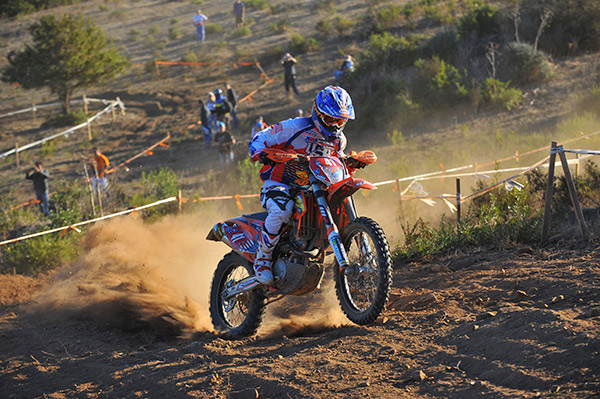
Caselli died competing in that race after colliding with a large animal. He was survived by his mother Nancy, sister Carolyn, fiancée Sarah, other family members, and countless friends and fans.
Kurt Caselli is remembered for his incredible skill and talent on an off-road motorcycle, but perhaps his greatest, and most lasting, impact was his role, inspired by his father Rich, to foster a deep sense of team, dedication and patriotism among U.S. riders competing at the ISDE. Although Caselli didn’t live to see the fruits of his work, those efforts paid off in 2016 when the U.S. World Trophy Team won the World Trophy, an achievement that had eluded American riders since the event began in 1913.—James Holter
Kurt Caselli’s Accomplishments
Special Recognition
2007 AMA Sportsman of the Year.
National Championship Event Wins
Won Jan. 24, 2010, Desert MC National;
Feb. 13, 2011, Four Aces National;
April 23, 2011, Vikings National; Jan. 22, 2012,
Desert MC National; Feb. 12, 2012, Four Aces National;
April 22, 2012, Vikings National;
Oct. 14, 2012, So Cal MC National;
Oct. 28, 2012, 100’s MC National;
April 14, 2013, So Cal MC National;
April 28, 2013, Vikings MC National;
Aug. 24, 2013, Silver State Trailblazers National.
National Championships
Won the 2011, 2012 and 2013 AMA National Hare and Hound Championships.
International Event WINS
Won the 2012 Baja San Felipe 250, a race on Mexico’s Baja Peninsula organized by SCORE.
World Championship Event Wins
Won the 2013 Desafio Ruta 40 Rally in Argentina, a round of the FIM Cross-Country Rally World Championship Series.
World Championship Titles
Caselli was a member of the 2006 ISDE U.S. Junior Trophy Team that won its category at the FIM International Six Days Enduro in Taupo, New Zealand. His teammates included Ricky Dietrich, David Pearson and Russell Bobbitt. The four-rider squad beat some of the best woods riders in the world on a course that traversed hundreds of miles of trails over six days of competition.
Caselli led the team all week and finished second in his final moto test behind Belgium’s Joel Smets.
Mark Buckner
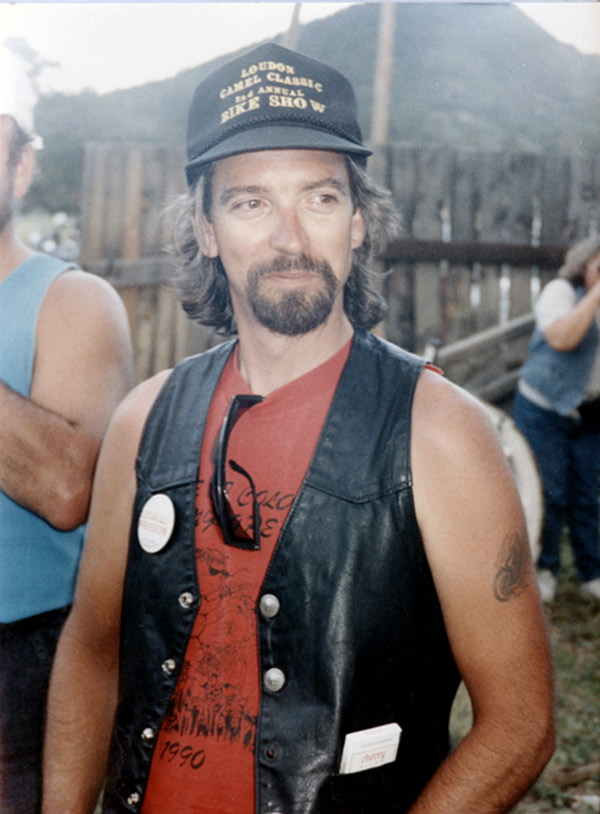 Mark Buckner was well into his motorcycling life when he took up advocacy in the 1980s.
Mark Buckner was well into his motorcycling life when he took up advocacy in the 1980s.
“I had ridden for many years, and I saw how the actions of the legislators affected motorcyclists,” he said. “Back in the early days, it was the helmet law and the inability to modify your bike.”
Buckner got involved with ABATE of Colorado in the 1980s, because he wanted to be a part of the effort to eliminate what he considered unfair treatment of motorcyclists.
“I’ve always supported helmets,” he said. “I am not anti-helmet. But I have never been in favor of requiring someone to wear one. I’ve always said that if somebody introduced a law saying you couldn’t wear a helmet, we’d fight that just as strongly.”
The motorcycling community at the time included a fair number of riders Buckner described as having “a hangover from the ’60s and ’70s.”
“People didn’t want the government telling them what to do,” he said. “I call it the ‘Western mentality.’ A lot of people lived out West because they valued their independence.”
In the late 1980s, Buckner moved into a leadership role in motorcyclists’ rights advocacy, becoming the state coordinator for ABATE of Colorado.
He immediately realized that the organization was underfunded and a little disorganized, resulting in a weak presence in state politics.
Buckner looked to ABATE of Indiana for guidance on how to create a powerful state motorcycle rights organization. And he forged strong bonds with the AMA and the Motorcycle Riders Foundation.
Under his leadership, ABATE of Colorado grew from 200 members to 2,000, established a firm financial base, built strong relationships with members of the state legislature and started the state’s rider education program.
“There was a handful of us at the time I started who wanted to make ABATE a strong and respected organization,” he said. “With a lot of help from a lot of people, we were able to turn things around.”
In 1992, Buckner joined the Motorcycle Riders Foundation board of directors, becoming MRF president and chairman two years later. During his tenure, the MRF implemented strategic planning processes which led to the organization’s financial stability and significant growth.
“In 1995, the AMA, the MRF and the SMROs all pulled together for the national helmet law repeal,” Buckner said. “It was really wonderful. We all carried the same message to Congress and pressed the message out to our members. That effort had the support of everybody.”
Buckner credits his success as an advocate and a leader to his passion and drive.
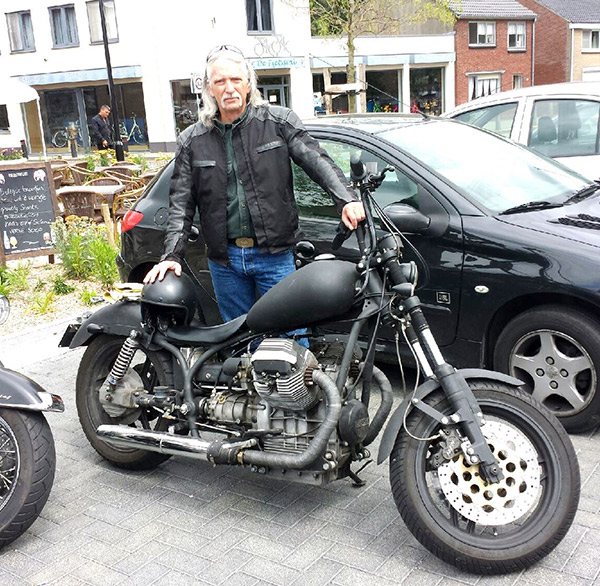
“I have never been short on either of those,” he said. “You just step up and volunteer. I learned on the fly, figuring out what motivates people, what works with the legislature.”
Buckner continues to have a profound influence in the motorcyclists’ rights community.
During the past 25 years, he has delivered more than 100 presentations around the country at state, regional, and national rights conferences.
Buckner also has been a leader in promoting global harmonization of motorcyclists’ rights organizations in the United States and has fostered working relationships within the European motorcyclists’ rights community.
In 2018, Buckner was inducted into the Motorcycle Riders Foundation Freedom Fighters Hall of Fame.—Jim Witters
Buckner’s motorcycles
Mark Buckner was 22 years old when he started riding motorcycles. But he had been listening to his father’s riding stories since he was a child.
“My first bike was a 1972 Suzuki GT750, the one they called the Water Buffalo, that my dad gave me,” he said. “It was a two-stroke with a power band that wouldn’t quit.”
By the time Buckner took up motorcycling, his father was infirmed and no longer riding.
“We never rode together, but his stories inspired me to ride,” he said.
Today, Buckner owns three motorcycles, all Harley-Davidsons: a 1977 Shovelhead, a 2008 Twin Cam and a 1992 Evo, which is the only vehicle he ever bought new.
Dale Walksler
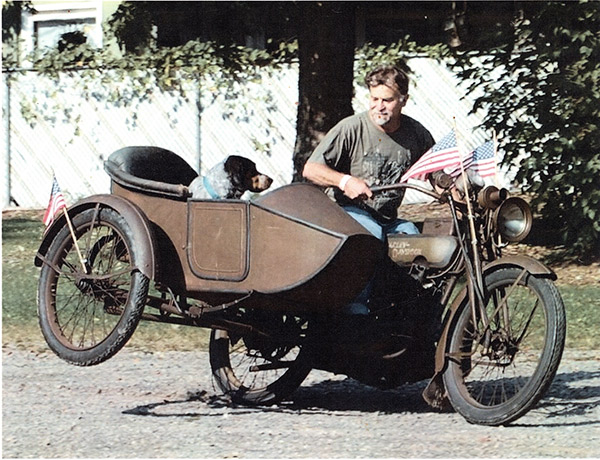 At a relatively early age, Dale Walksler demonstrated a flair for business and a passion for motorcycles.
At a relatively early age, Dale Walksler demonstrated a flair for business and a passion for motorcycles.
“My first motorcycle ride started as a bunch of 15-year-old kids hanging around a garage, looking at an old Panhead,” Walksler said. “I decided to buy the old bike and drive it home.”
That “old bike” was a Harley Servi-Car. He made the deal, and his motorcycling adventure began.
Throughout his high school years in Glen Ellyn, Ill., Walksler bought and sold Harley-Davidson parts. Then in 1970, at the ripe old age of 18, he opened his own store, called Dale’s Hogs.
Just four years, later, Walksler became one of the youngest Harley-Davidson dealers in the country. He was 22 when he opened his dealership in Mount Vernon, Ill.
As his business grew, he moved his motorcycle collection to the dealership to attract customers. In 1999, Walksler sold the dealership and relocated his motorcycle collection to Maggie Valley, N.C. The new museum opened in 2002.
“Noticing that people enjoy old motorcycles is nothing new to me,” he said. “And from the very start, I realized that people will travel long and far to see a collection of rare old motorcycles. And I created Wheels Through Time just for that reason.”
Dale’s Wheels through Time Museum sets itself apart from most other museums by featuring motorcycles in running condition.
“The dropping jaws, the never-ending compliments on the collection. The most satisfying aspect of Wheels Through Time is the reaction of the people who visit,” Walksler said. “They are always aghast when they see the vast collection of rare motorcycles. And when they see them run, it takes it one step to the next note.”
Walksler’s museum features more than 350 bikes that trace the evolution of motorcycling from its earliest days into the 1960s. Walksler said he chose the location because Maggie Valley already was a tourist town.
“To build a museum there is something that would be a plus for the tourism industry,” he said. “And it would be a no-brainer to build the vast collection known as Wheels Through Time.”
He said the biggest challenge was staffing the museum with “people who understand my vision.”
“Finding those people is not an easy thing to do, but I have managed for 17 years now to do that,” Walksler said. “It’s a task I look forward to every day. Inspiring our visitors, inspiring our guests and inspiring our staff is something that’s hugely important to the overall impact.
“Our staff of museum docents is second to none,” he said. “We keep three to five people on the floor every day, sharing the stories of American history, starting bikes and sharing that story. It’s something you’ll see at no other museum in the world, as far as I know. And Wheels Through Time specializes in having a great customer experience.”
That customer experience is what drove the success of Walksler’s motorcycle dealership, as well.
“There’s not a huge difference between running a museum and running a motorcycle dealership,” he said. “It’s all about customer satisfaction and making sure each and every customer is pleased with the result of the experience that they’ve had. We entertain hundreds of people every day, and it is our goal to have their experience equal or exceed the visitor prior to them, one after another.”
Although the museum is open to the public only six months each year, more than 100,000 visitors pass through its exhibits annually. From December through April, the staff restores bikes and arranges new exhibits.
The museum’s popularity earned Walksler appearances on several television programs about vintage car and motorcycle restoration, including “American Restoration,” “Chasing Classic Cars,” “American Pickers” and his own show “What’s in the Barn?”
Those shows helped popularize vintage motorcycling, as well as put forward a positive image of the motorcycling lifestyle.
Wiltz Wagner
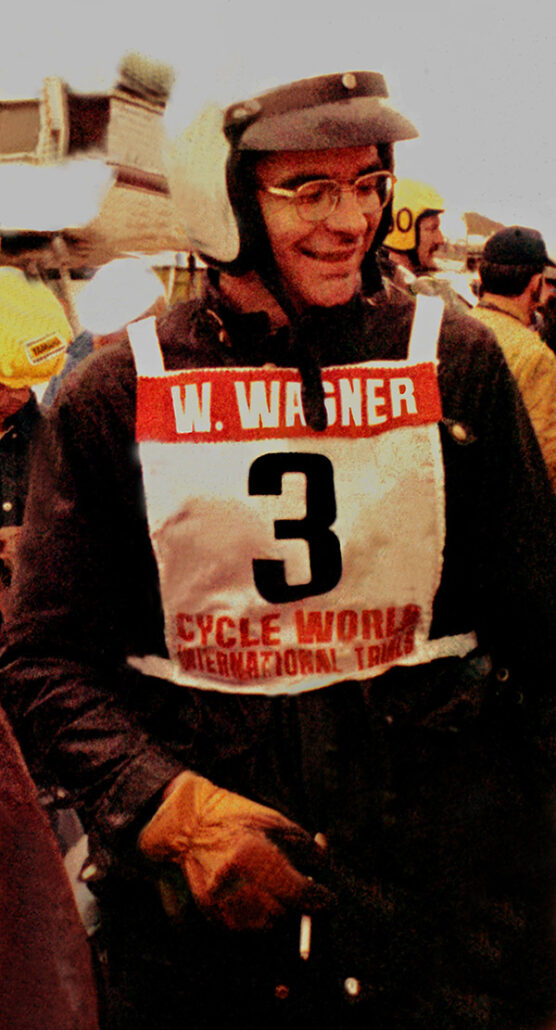 Since the 1960s, Wiltz Wagner has been deeply involved in the sport of observed trials, first as a fierce competitor and, later, as an unwavering advocate who helped gather scattered groups of enthusiasts and clubs into a cohesive national organization.
Since the 1960s, Wiltz Wagner has been deeply involved in the sport of observed trials, first as a fierce competitor and, later, as an unwavering advocate who helped gather scattered groups of enthusiasts and clubs into a cohesive national organization.
Living in Denver, Wagner was first attracted to motorcycles as a way to explore the mountain trails. But competitive riding was not his first choice as an outlet for his sporting desires.
He tried target pistols, martial arts and fencing, but each of those disciplines disappointed him in one way or another.
“I was looking for something to compete with, something sporting,” he said. Then he saw an observed trials.
“It looked like something I could do,” Wagner said. “I said, ‘Give me a bike. I think I can ride better than that guy.’”
He started with a 175cc Kawasaki Bushwacker, “which was quite a challenge to ride in trials.” Then Wagner bought a Montesa Cota.
“I loved the people, and I thought the sport was fascinating,” Wagner said. “That became it for me. I never did any of the other things [competitive sports] again.”
At 28, Wagner was starting in trials at an age when many top competitors retire.
“I had a lot of catching up to do,” he said. “The riders who started out as kids were wired differently. They could watch someone do something on the course, then use it right away. It took me weeks to do that.”
So, Wagner dedicated himself to the task. He trained four hours a day after work and spent weekends on his bike. He got up for 5 a.m. workouts.
“The competition became a measuring stick for how well the practice was going,” he said.
Eventually, Wagner and a few of his fellow Colorado riders began traveling to California and other states to compete in trials events. And they began to see the potential for more organization on a state—and even national—scale.
Wagner formed Colorado’s Rocky Mountain Trials Association, one of the oldest AMA-chartered trials clubs in America. The club is run by a steering committee that talks things through to reach a decision. There are no officers and no elections, Wagner said.
When Wagner left Colorado in 1985, after 25 years in the state, the RMTA had more than 225 members and put on 30 to 40 events a year.
Outside of Colorado, the trials community supported large events in Southern California, Texas and Michigan.
In 1973, Dick Debolt and the Michigan-Ontario Trials Association staged a two-day North American Trials Championship. Wagner was there.
“We saw that people were ready to travel to compete,” Wagner said. “Debolt showed that it could work.”
So, Wagner started putting together a list of all the trials clubs in the country and collected their membership rosters.
“That was the key,” he said. “Once you had the lists, you could reach out to the members.”
That outreach was the genesis of the North American Trials Council.
In 1974, the NATC put on nine events.In 1975, The Rhode Island Trials Club worked with Wagner and the NATC to host the first World Trials Championship in New England.
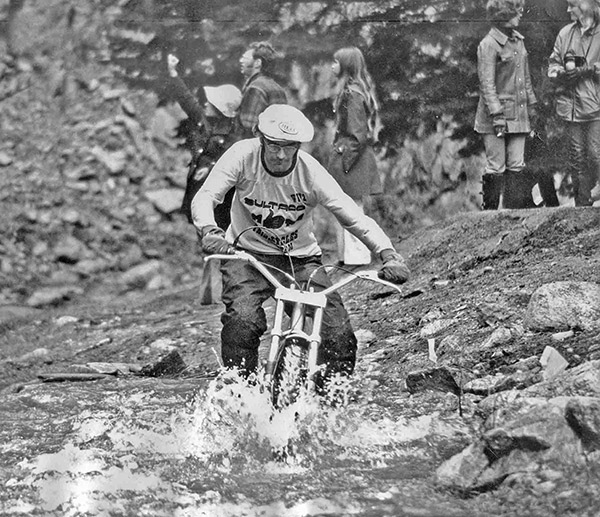
For the past 46 years, the NATC series, sanctioned by the AMA, has crowned the sport’s national champion.
Wagner was inducted into the NATC Hall of Fame in 2005 for his contributions to trials.
But he has competed and won in other disciplines, including drag racing, ice racing and land-speed racing where he, his late wife and his daughter hold more than 50 records.
Wagner said his selection for the AMA Motorcycle Hall of Fame was somewhat of a surprise, because “trials is not a front-and-center sport.”
“It’s a hall of fame, and you don’t get a lot of fame if you are hiding in the woods with a bunch of your friends riding motorcycles,” he said. “But I am over the moon. This honor shines a spotlight on this sport.”—Jim Witters
See History Happen
Fans of motorcycling and supporters of the AMA Motorcycle Hall of Fame are invited to attend the 2019 AMA Motorcycle Hall of Fame Induction Ceremony Dec. 6 at the Hilton Columbus Downtown in Columbus, Ohio.
Attendees will witness first-hand the induction of five incredible motorcyclists who helped shape motorcycling in America.
The festivities takes place in the heart of Columbus’ active nightlife district, bridging the Arena District and the Short North. And it’s all just a 20-minute drive to Pickerington’s Hall of Fame museum, which will host a luncheon the Saturday following the induction ceremony.
All proceeds from the event support the American Motorcycle Heritage Foundation, the 501(c)(3) charged with funding the Hall of Fame.
You can register now at www.americanmotorcyclist.com > Events > AMA Legends & Champions, or by calling (614) 856-1900.

